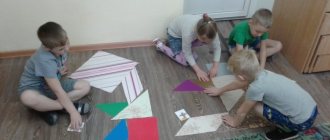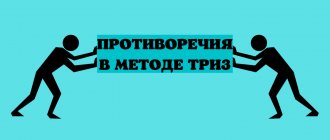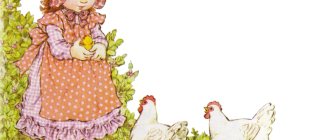Card index of games using TRIZ technology elements
Thumbelina is light, and the swallow is large;
Pierrot has long sleeves, and Malvina has blue hair, etc.
44. Eurorhythm is a fantasy technique in which a specific object is viewed according to plan:
1. Function and contradictions in a given object;
2. Options by which the object is presented (fantasizing: what options do not exist?);
3. Analysis of the situation: this object is the only one left on earth, what could be the consequences of this?;
4. Analysis of the situation: the object has disappeared, how will the function be performed?;
5. Analysis of the reasons in the situation: the object exists, but the function is not performed;
6. Inventing new objects by combining this object with others (can be arbitrary).
45. Circles of Lull.
The tool consists of several circles of different diameters strung on a common rod. An arrow is installed at the top of the rod. All circles are divided into the same number of sectors. The circles and arrow are movable. The free rotation of all parts leads to the fact that certain sectors on each of the circles appear under the arrow. The purpose of this manual: to clarify the knowledge of preschoolers in various subject areas; develop the variability of imaginary images. "Make a Word" - used to form words. “Color mixing” - consolidating the production of color and its shades. “Compose a fairy tale” - used to compose various versions of fairy tales.
46. Manual “Caterpillar”
forms the ability to compare objects according to several different characteristics. Compose riddles using signs presented in the form of visual symbols. Learn to classify objects according to these characteristics and compose descriptive stories.
47. "Magic Path"
The plot of many fairy tales is based on the actions of a hero: he travels for a specific purpose, interacts with other objects (overcomes obstacles, solves problems, while changing himself and changing objects of interaction), and can learn a lot.
48. “Didactic ball”
The “Didactic Ball” manual is actively used at a young age, with the help of which we teach children to find words - antonyms. Let's give an example of using the manual in different age groups. Tasks for children 4 years old. The teacher offers a word - a noun (adjective, verb), and the child says the opposite in meaning. Example: sadness - joy; White black; cry - laugh.
49. Manual “Clock”
Symbols for feature names were introduced gradually: from simple ones (color, shape, size) to more complex ones (temperature, weight, distance, smell, etc.). In the manuals, 17 names of characteristics were placed, and additional empty cells were left for the future. The manual became universal: it was used in different types of classes and as an algorithm for composing descriptive stories and riddles.
Top most popular games used by TRIZ teachers
This collection contains the most popular games that are used in TRIZ pedagogy. These are the most famous and effective games, and not all possible ones. Since all the possible ones would hardly fit even in a weighty volume, moreover, their number is constantly growing. The fact is that TRIZ pedagogy, like a sponge, absorbs all the effective tools that develop thinking and creativity. And the most proven ones remain in the arsenal of TRIZ teachers and are successfully used in the classroom.
Check yourself, are you familiar with all the educational games from the selection? And if so, are you using all the games as efficiently as possible?
The selection can be useful both for new TRIZ teachers and for all teachers and parents who are involved in the development of thinking in children.
1) YES-NO
Recommended age: from 7 to 100 years.
The essence of the game: the presenter makes a wish for something. Participants guess what by asking questions. But you can only ask questions that the presenter can answer “yes” or “no.”
One of the simple questions, for example: “Guess what kind of food I ordered?”
What are the benefits of the game? We train the ability to ask strong questions. Within the framework of the game, these are those that cut off many possible answers at once. We also train our memory - because in order to solve the subject, you will have to remember many previous answers in your head!
Additional ideas: at some point, players may form an algorithm for solving (a clear sequence of strong questions). Then change what you wish for! Let this time it be not an object, but a hero of a book or film. Have you gotten used to it? Great, let's come up with other types of yes-no. For example:
- Yes-no under a microscope;
- Yes-no from the pictures;
- Yes-no about ancient species.
The main thing is not to forget to mark strong questions. You can also complicate the conditions - for example, you can ask no more than 10 questions. Did you manage? And now no more than 7. Is it hard to guess in 5 questions? There is no limit to perfection 
2) DRUDL
Recommended age: From 5 to 100 years.
The essence of the game: the presenter offers to look at some incomprehensible abstract picture. Participants come up with as many options as possible for what this image looks like.
What are the benefits of the game? Such visual riddles are used in TRIZ pedagogy to develop imagination; they also work well as a warm-up to activate creative thinking before subsequent tasks.
Additional ideas: you can not only look at droodles, but also draw and complete them yourself one by one. For example, the first participant drew a doodle, and the second completed it to some kind of full-fledged object and vice versa.
You can continue to draw the same doodle, because the more options you find, the more you will boost your imagination. Examples here.
Droodles can also be found in real life, for example, on a fence. Examples here.
Examples here.
Tree crowns and clouds serve as excellent droodles for a walk. On the road, you can even take a photo of the cloud on your phone and finish drawing it in any drawing program:
Or maybe it’s more convenient for you to solve droodles in the form of short animated videos? And the cartoon format is closer to children. Then you can use the selection of video doodles on our YouYube channel TRIZiKot.
3) MAGNETIC ANOMALY
Recommended age: from 5 years to 8 years.
The essence of the game: imagine that we find ourselves on a mysterious planet. It is almost the same as ours, but magnetic anomalies very often appear on it. All inhabitants of the planet, in order not to fly into outer space, need to, at the command of the presenter, have time to “magnetize” to a certain object.
What are the benefits of the game? With its help, you can master various properties of objects in an active form, as well as develop ingenuity and creativity.
Additional ideas: Objects in a game can be either items or properties. For example, “let’s magnetize to the wall!” or “let’s get magnetized to green!” And when simple objects and signs are mastered, we begin to get creative. For example, in a room where there are no plants, say “attach to something growing.” Here you need to realize that people also grow. Or maybe we can find some even more unusual answer?
Or “magnetize yourself to the ceiling” - this problem still needs to be solved before you implement it 
By the way, to make it more fun and active, we play for speed and turn on the countdown! 5…4…3…2…1…!
A detailed description of the game, video instructions and a list of properties that you can play can be found at the link.
4) SUN-DOG-TOMATO
Recommended age: from 10 to 100 years.
The essence of the game: this exercise is similar to “Find the extra one,” only in reverse. The task is to find a unifying feature between two objects and exclude the third.
What are the benefits of the game? According to the author, with the help of the game you can even create a new convolution for yourself. But only if you reach a new level of solution, find a new area of comparison that other participants in the game have not yet found, and which was not on the surface!
But only if you reach a new level of solution, find a new area of comparison that other participants in the game have not yet found, and which was not on the surface!
Additional ideas:
A detailed description of the exercise from the author Sergei Faer is at the link.
You can see how participants find new levels of solutions here.
5) Good-bad
Recommended age: from 10 to 100 years.
The essence of the game: the presenter names any phenomenon or event (for example, winning the lottery), and the participants take turns calling what is good about it and what is bad about it.
What are the benefits of the game? The game trains the ability to find and identify contradictions - one of the main skills of “TRIZ” thinking. Indeed, at the heart of almost every inventive problem lies precisely the contradiction: “in some ways this is good, but in some ways it is bad.” After correctly formulating the contradiction, the problem is much easier to solve.
Additional ideas:
“Good and Bad” can be played in another way. For example, build a chain where participants find the pros and cons of not one event, but its various consequences. For example, the presenter says the first negative fact: “I slipped on the ice,” the first participant must say why this is good, for example, “next time I will be more careful.” And the next participant must say why the previous fact is bad: “I will look too carefully at my feet and will not notice the friend who was walking from the other side of the street” and so on. Another version of the “Good-Bad” game - training on turning harm into benefit - can be viewed at the link.
6) Universal item
Recommended age: from 6 to 100 years.
The essence of the game: we choose any object that is familiar to us and ask us to come up with how it can be used in another way? In addition to the main purpose. For example, a chair!
What are the benefits of the game? The exercise trains the ability to see not only the main function of an object (what it was created for), but also hidden functions (what else it might be useful for, for example, in some unusual situation).
Additional ideas:
The main thing in this exercise is not to stop at the first answers. After all, only when the brains begin to creak does progress occur. You can see how participants find new uses for such an ordinary object as a chair - here.
7) Break the stereotype
Recommended age: from 10 to 100 years.
The essence of the game: you need to choose several templates/known facts/stereotypes and come up with situations where they do not work. For example: The snow is cold. The fire is hot. The water is wet.
What are the benefits of the game? One of the key characteristics of an inventor's mindset is the ability to think outside the box. Seeing the unusual in the ordinary, seeing differently, in general, breaking the mold. The game will help to break the inertia of thinking and get out of the “automatic mode” of the brain.
Additional ideas:
You can watch how the participants play “Break the Stereotype” by following the link.
A version of the game for kids is “Edible - Inedible”. Choose any inedible object and figure out when it can be edible (an edible ball in the form of a cake or when made from fruit). And vice versa, when something edible can be inedible (an apple when it is old or plastic).
A version of the game for adults is “Paradoxes”. We combine two qualities together, for example “Living” and “non-living”. And we come up with an answer to the question: “What can be both living and nonliving at the same time?” . Possible answers from participants.
 Creative fight
Creative fight
Recommended age: from 8 to 100 years.
No one will get hurt in a creative fight. But the brain will be well trained on open tasks.
What is this? Open problems are those problems that are found in real life, and not on the pages of ordinary school textbooks. In open problems, as a rule, there are no clear conditions; there may be several solutions and not just one correct answer - but many. An entire section is devoted to the theory of Open Problems on the Education for a New Era portal.
How to play open challenges? Based on solving open-ended problems, the intellectual team game Creative Fight was created. Participants are divided into teams and solve open-ended problems. Their decisions are evaluated according to special parameters. You will find more information about the rules of the game, nuances, as well as tasks that you can play on the Creatime portal.
Additional ideas:
You can also add an active element to solving open problems! To begin with, we set any open tasks for the participants, for example:
- A coin sinks in water, but how can you prevent it from sinking?
- Clothes get dirty, but how can you prevent them from getting dirty?
- How to prevent a balloon from bursting?
And then you are free to figure out which activity element to include! For example, participants stand at the start, and for each decision made, the participant jumps forward and approaches the finish line. Who will get there first?
Or the participants stand against the same wall. Everyone comes up with solutions. If someone has not come up with a solution, then instead of answering, he can do a physical exercise, for example, bend his arm and walk back and forth to the opposite wall. Then, if there is no answer again, bend your other arm and walk again, then your leg, and so the task of walking will gradually become more difficult.
Or include a ball in generating answers. Whoever catches the ball must come up with a solution and throw it to the next player.
9) Additional materials
There are many more games from the arsenal of TRIZ teachers that are not included in this top, but are compactly collected and presented in cards. For example, these are games for writing fairy tales, for systems thinking, for cause-and-effect relationships.
For information on how to get games in cards, follow the link.
Big request:
Do you think that some cool and effective educational game was not included in this list? We will be glad if you add to it and tell us about this game in the comments!
Thank you in advance!
The TRIZiKot project is educational games, exercises and cartoons for children, parents and teachers.
You can register for seminars on TRIZ pedagogy for teachers
Here.
Do you want to not miss new interesting articles and keep up to date with our news? Subscribe to our newsletter! A letter with all new site materials, announcements and news will come to you once a month.






